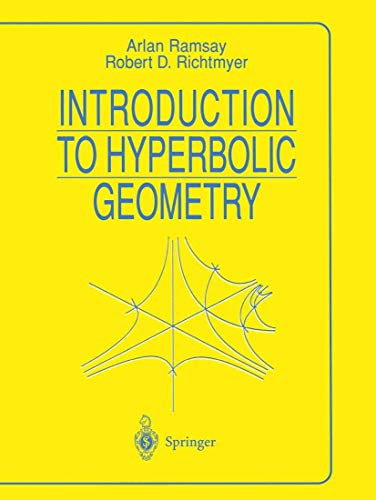
Synopsis
This book is an introduction to hyperbolic and differential geometry that provides material in the early chapters that can serve as a textbook for a standard upper division course on hyperbolic geometry. For that material, the students need to be familiar with calculus and linear algebra and willing to accept one advanced theorem from analysis without proof. The book goes well beyond the standard course in later chapters, and there is enough material for an honors course, or for supplementary reading. Indeed, parts of the book have been used for both kinds of courses. Even some of what is in the early chapters would surely not be nec≠ essary for a standard course. For example, detailed proofs are given of the Jordan Curve Theorem for Polygons and of the decomposability of poly≠ gons into triangles, These proofs are included for the sake of completeness, but the results themselves are so believable that most students should skip the proofs on a first reading. The axioms used are modern in character and more "user friendly" than the traditional ones. The familiar real number system is used as an in≠ gredient rather than appearing as a result of the axioms. However, it should not be thought that the geometric treatment is in terms of models: this is an axiomatic approach that is just more convenient than the traditional ones.
"synopsis" may belong to another edition of this title.
Review
"The book is well laid out with no shortage of diagrams and with each chapter prefaced with its own useful introduction...Also well written, it makes pleasurable reading." Proceedings of the Edinburgh Mathematical Society
Synopsis
This text for advanced undergraduates emphasizes the logical connections of the subject. The derivations of formulas from the axioms do not make use of models of the hyperbolic plane until the axioms are shown to be categorical; the differential geometry of surfaces is developed far enough to establish its connections to the hyperbolic plane; and the axioms and proofs use the properties of the real number system to avoid the tedium of a completely synthetic approach. The development includes properties of the isometry group of the hyperbolic plane, tilings, and applications to special relativity. Elementary techniques from complex analysis, matrix theory, and group theory are used, and some mathematical sophistication on the part of students is thus required, but a formal course in these topics is not a prerequisite.
"About this title" may belong to another edition of this title.
Other Popular Editions of the Same Title
Search results for Introduction to Hyperbolic Geometry (Universitext)
Introduction to Hyperbolic Geometry
Seller: Midway Book Store (ABAA), St. Paul, MN, U.S.A.
Paperback. Condition: Near Fine. First printing. 23.5 x 15.5 cm. 287pp. 59 figures, Index. Yellow softcover. Spine is lightly sunned. Universitext. Seller Inventory # 81577
Introduction to Hyperbolic Geometry
Seller: Better World Books, Mishawaka, IN, U.S.A.
Condition: Very Good. Former library book; may include library markings. Used book that is in excellent condition. May show signs of wear or have minor defects. Seller Inventory # 15409134-20
Introduction to Hyperbolic Geometry (Universitext)
Seller: World of Books (was SecondSale), Montgomery, IL, U.S.A.
Condition: Good. Item in good condition. Textbooks may not include supplemental items i.e. CDs, access codes etc. Seller Inventory # 00094802256
Introduction to Hyperbolic Geometry (Universitext)
Seller: Lucky's Textbooks, Dallas, TX, U.S.A.
Condition: New. Seller Inventory # ABLIING23Feb2215580174026
Introduction to Hyperbolic Geometry
Seller: GreatBookPrices, Columbia, MD, U.S.A.
Condition: New. Seller Inventory # 4900139-n
Introduction to Hyperbolic Geometry (Universitext)
Seller: Ria Christie Collections, Uxbridge, United Kingdom
Condition: New. In. Seller Inventory # ria9780387943398_new
Buy New
Ships from United Kingdom to U.S.A.
Quantity: Over 20 available
Introduction to Hyperbolic Geometry
Seller: GreatBookPrices, Columbia, MD, U.S.A.
Condition: As New. Unread book in perfect condition. Seller Inventory # 4900139
Introduction to Hyperbolic Geometry
Seller: GreatBookPricesUK, Woodford Green, United Kingdom
Condition: New. Seller Inventory # 4900139-n
Buy New
Ships from United Kingdom to U.S.A.
Quantity: Over 20 available
Introduction to Hyperbolic Geometry
Seller: Chiron Media, Wallingford, United Kingdom
PF. Condition: New. Seller Inventory # 6666-IUK-9780387943398
Buy New
Ships from United Kingdom to U.S.A.
Quantity: 10 available
Introduction to Hyperbolic Geometry
Seller: BuchWeltWeit Ludwig Meier e.K., Bergisch Gladbach, Germany
Taschenbuch. Condition: Neu. This item is printed on demand - it takes 3-4 days longer - Neuware -This book is an introduction to hyperbolic and differential geometry that provides material in the early chapters that can serve as a textbook for a standard upper division course on hyperbolic geometry. For that material, the students need to be familiar with calculus and linear algebra and willing to accept one advanced theorem from analysis without proof. The book goes well beyond the standard course in later chapters, and there is enough material for an honors course, or for supplementary reading. Indeed, parts of the book have been used for both kinds of courses. Even some of what is in the early chapters would surely not be nec essary for a standard course. For example, detailed proofs are given of the Jordan Curve Theorem for Polygons and of the decomposability of poly gons into triangles, These proofs are included for the sake of completeness, but the results themselves are so believable that most students should skip the proofs on a first reading. The axioms used are modern in character and more 'user friendly' than the traditional ones. The familiar real number system is used as an in gredient rather than appearing as a result of the axioms. However, it should not be thought that the geometric treatment is in terms of models: this is an axiomatic approach that is just more convenient than the traditional ones. 304 pp. Englisch. Seller Inventory # 9780387943398

